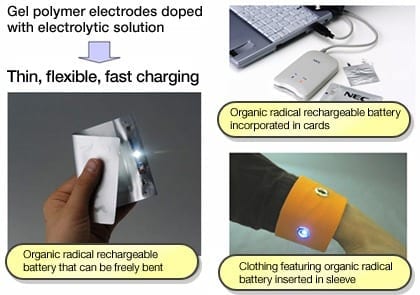
Transporting power sources in the coldest places may be easier with a new re-chargeable, non-metallic battery from Japan. This “eco battery” could provide portable sources of power in environments like refrigerated factories or extreme winter environments.
Chemists from Hiroshima University developed a new synthesis method for organic radical batteries that are re-chargeable and continue to function at below-freezing temperatures. The specific model prototyped by the Hiroshima University team has greater voltage than previously reported styles from other research groups around the world. The method used to create this battery is an improvement on a report from the same Hiroshima University laboratory earlier in 2016.
Most electrical devices use a lithium-ion battery. Lithium-ion batteries are safer than standard lithium metal batteries, but both styles rely on metal, a finite resource that is in decreasing supply. The same problem of decreasing supply exists for copper and cobalt batteries, like the traditional AA batteries in TV remote controls.
Organic radical re-chargeable batteries have the potential to be cheaper, safer, and longer-lasting than current metal-based batteries, earning them the “eco battery” title. This style of battery can re-charge faster than meal-based batteries, the difference of one minute instead of one hour, because they carry energy chemically rather than physically.
“The chemicals in the battery make it heavy and the synthesis process makes it expensive, so it won’t replace other styles of batteries in the foreseeable future. But our battery could supplement traditional batteries in conditions where traditional Lithium-ion batteries can’t work reliably, particularly in cold locations,” said Professor Yohsuke Yamamoto, Ph.D., from Hiroshima University.
Eventually, organic radical batteries could potentially be made in flexible, transparent forms for use in wearable electronics.
The new organic radical synthesis method from the team of researchers at Hiroshima University is modeled on a process first report in 1985 by an American research group. Yamamoto was a member of that lab in the late 1980s and improved the process in recent years as part of work on unstable organic compounds.
“The original method we used took such a long time and relied on harmful chemicals. Now, over 20 years later, we can synthesize the compound much more quickly and safely.
“Fundamental research on unstable compounds creates a more detailed understanding of how chemicals bond. Applications like this new battery are the results of research that was never originally about any specific end product,” Yamamoto said.
Yamamoto and collaborators are currently adapting the synthesis process further to make the battery lighter weight and ensure it retains its energy output after numerous re-charge cycles.
Learn more: Power up when the temperature is down
The Latest on: Organic radical re-chargeable batteries
[google_news title=”” keyword=”Organic radical re-chargeable batteries” num_posts=”10″ blurb_length=”0″ show_thumb=”left”]
via Google News
The Latest on: Organic radical re-chargeable batteries
- Batteries Newson May 5, 2024 at 5:00 pm
May 2, 2024 — Charge-recharge cycling of lithium-superrich iron oxide, a cost-effective and high-capacity cathode for new-generation lithium-ion batteries, can be greatly improved by doping with ...
- WATCH: How rechargeable batteries can burst into flameson May 2, 2024 at 12:52 pm
In a dramatic display of what can happen when rechargeable batteries are thrown in the garbage, fire officials in Montgomery County, Maryland, intentionally allowed several batteries to catch fire ...
- How we test rechargeable batterieson April 30, 2024 at 5:00 pm
Our independent rechargeable battery reviews tell you what you need to know about a rechargeable battery before you buy a pack. This means you will only buy the best rechargeable batteries - the ones ...
- Research team improves voltage of aqueous rechargeable batteries in the quest for safer, cheaper optionson April 30, 2024 at 6:10 am
A QUT-led team of international researchers has made a breakthrough in the development of a type of battery that is much safer and cheaper than the batteries currently charging our smart devices.
- Best Rechargeable Hearing Aids Of 2024, According To Audiologistson April 29, 2024 at 10:39 pm
Rechargeable hearing aids are often a helpful solution, with batteries lasting more than 24 hours on a single charge in some models, plus Bluetooth compatibility, accompanying apps that host ...
- Your guide to recycling clothing, makeup, electronics, batteries and more in Phillyon April 21, 2024 at 5:00 pm
What they take: TVs, stereos, gaming consoles, "pretty much anything that doesn't work" Mom's Organic Market Location ... lead-acid and rechargeable batteries Home Depot Locations: 1651 S.
- More economical and sustainable rechargeable batterieson April 21, 2024 at 5:00 pm
The drawback for these has been that the battery cell decomposes more solvent than the few salt anions, which leads to an organic-dominated ... has been working in the rechargeable batteries ...
- Best Solar Batteries Of 2024on April 10, 2024 at 6:56 am
Enter solar batteries: the unsung heroes of the solar energy world. These powerhouses not only store energy gleaned during sun-soaked hours but also ensure that homes remain illuminated during ...
- Why Batteries Come in So Many Sizes and Shapeson April 9, 2024 at 5:00 pm
First, there are the round, non-rechargeable button cells for your watches and small items. There’s also the popular AA and AAA cylindrical batteries for calculators, clocks and remotes.
- Why batteries come in many different shapes and sizeson April 8, 2024 at 6:46 am
First, there are the round, non-rechargeable button cells for your watches and small items. There’s also the popular AA and AAA cylindrical batteries for calculators, clocks and remotes.
via Bing News










